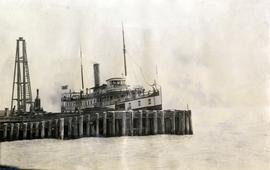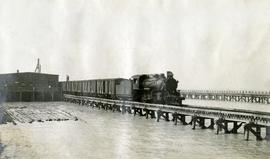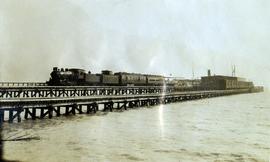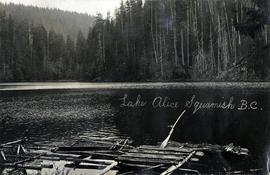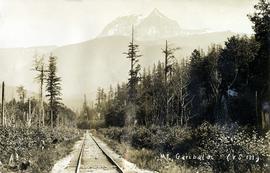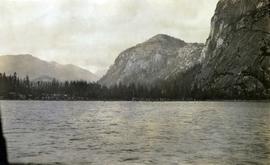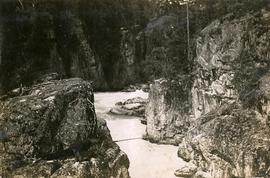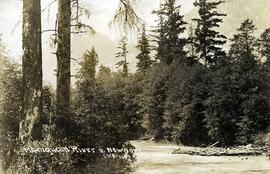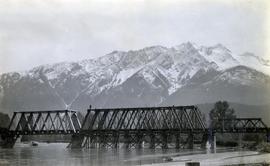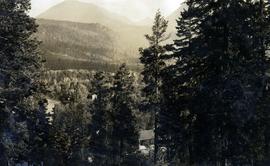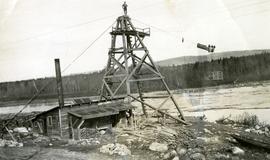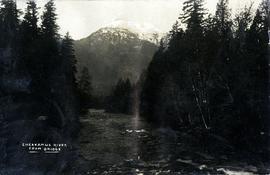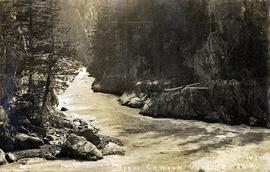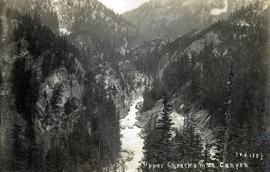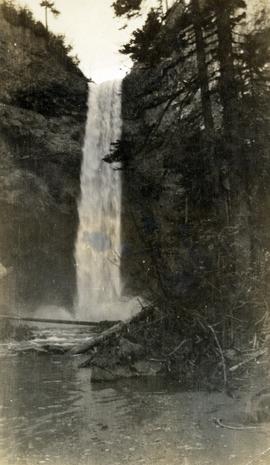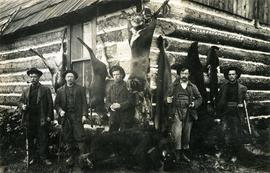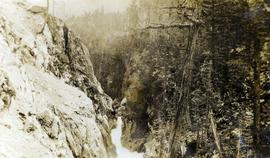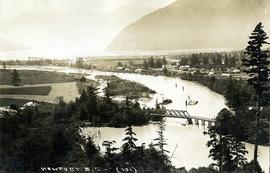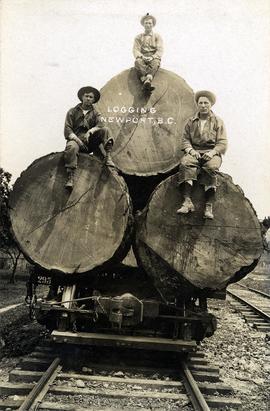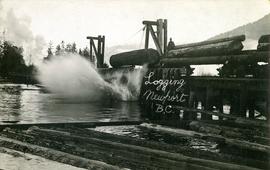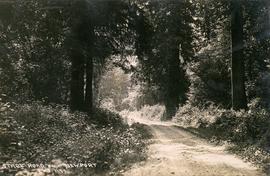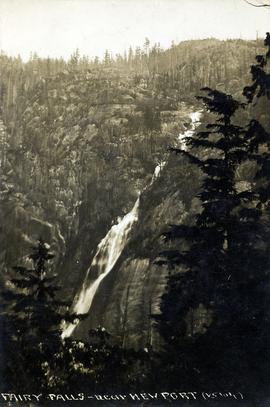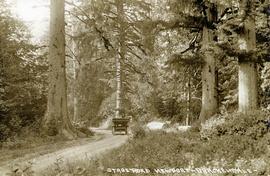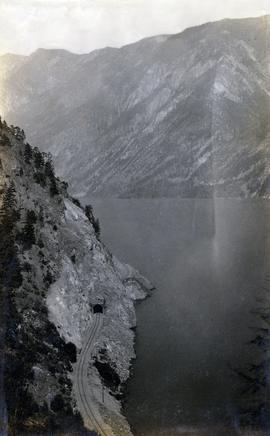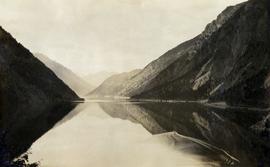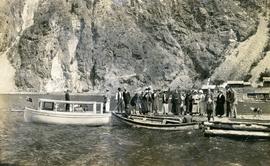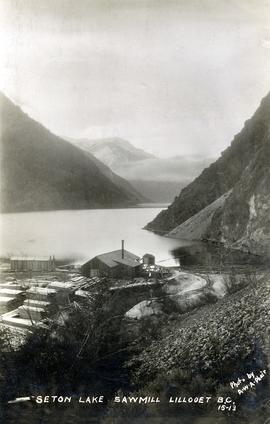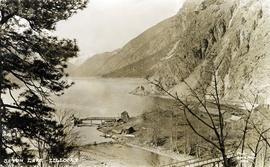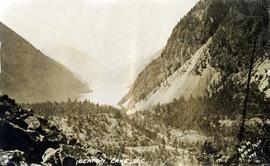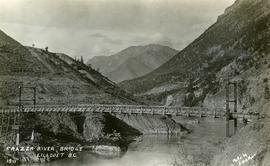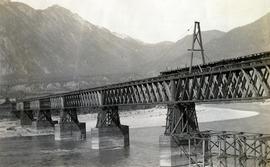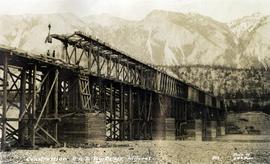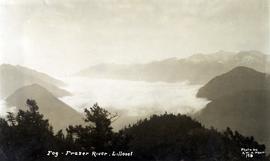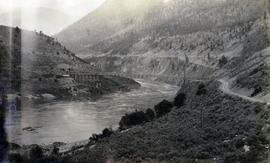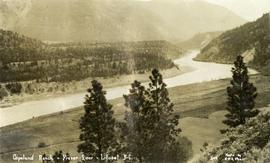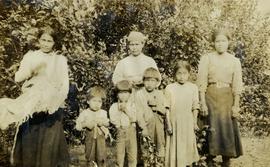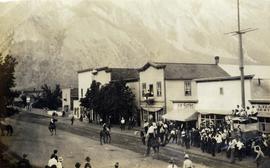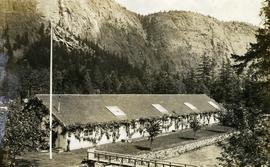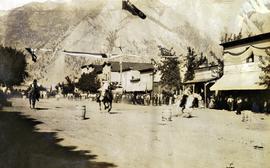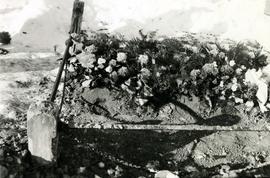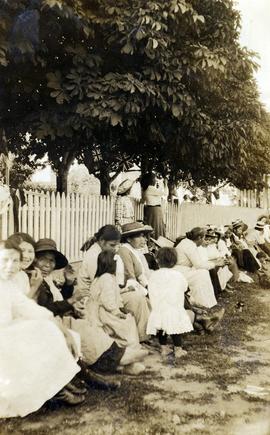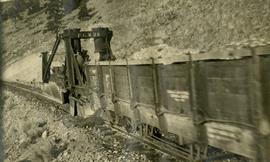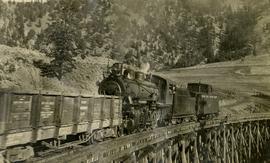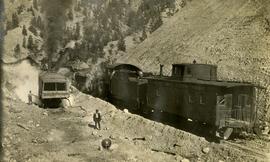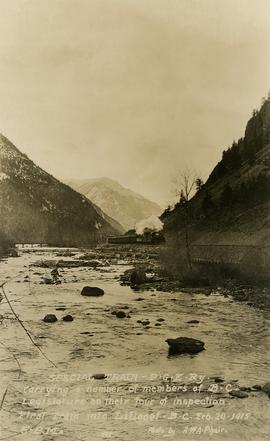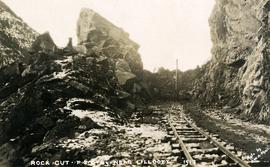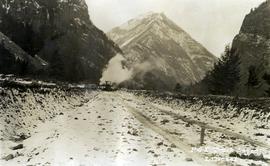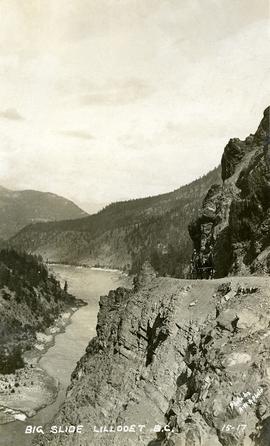This collection consists of photographs and "real photo" postcards that depict the construction and operation of the Pacific Great Eastern Railway line, communities nearby the railway line, and regional geography of areas adjacent to the PGE line.
Photograph depicts the "MV Ballena" docked at a wharf. The Ballena was a passenger ferry built in 1892 by the Albion Iron Works Company of Victoria and originally named the Joan. This ship was sold to the Terminal Steam Navigation Company in 1914 and renamed the Ballena. It was later acquired by the Union Steamship Company in 1920 but burned at the Union dock in November of that year.
Photograph depicts a Pacific Great Eastern Railway train at the Squamish dock.
Photograph depicts a Pacific Great Eastern Railway train on the original dock at Squamish (Newport); the vessel in the distance behind the warehouse is quite likely the "MV Ballena", the subject of photograph 2020.08.01.
The equipment shown in this photograph is: Locomotive 51 or 52, built by Montreal Locomotive Works in 1913; caboose C-1, built by National Steel Car, Hamilton, Ontario in 1914; baggage-mail car 51 or 52; passenger coach 2, 3 or 4; and an unknown flat car outfitted as a sightseeing car with canopy. The time-frame for the photograph is between June 8, 1915 (when baggage-mail cars 51 & 52 arrived at Newport Dock) and some time in 1918 (when caboose C-1 was re-numbered to 1801).
Additional information on baggage-mail cars 51 & 52 and coaches 2, 3 & 4:
Baggage and mail cars 51 and 52 were purchased from E.H. Wilson & Co. of Philadelphia at a total cost of $2806.74 each. They were received on line June 4, 1915 and were barged to Newport on June 8. These cars had a length of 64 ft. over buffers, an inside length of 60 ft. and an inside width of 9 ft. 2½ in. and rode on 6-wheel trucks. Although not confirmed, these cars are believed to be of Pennsylvania Railroad heritage with PRR Class MM baggage and mail cars being the most likely candidates. Certainly, all the other cars purchased from E.H. Wilson & Co. were ex-Pennsylvania and the gasoline lighting system with which these cars were delivered was used extensively by the PRR.
Coaches 2, 3, & 4 are former Pennsylvania Railroad Class “PK” closed vestibule coaches #s 3077, 3080, & 3092 which were received on June 10, 1914 after being purchased from E.H. Wilson & Co. for $3859.11, $3858.87 & $3858.87 respectively. They were built by the PRR in 1905, 3070 and 3088 at Altoona Car Shops and 3092 at the Wilmington, Delaware shops of subsidiary Philadelphia, Baltimore and Washington. All had been assigned to P.B. & W. service. The Official Railway Equipment Register lists these cars as 62 ft. long with a capacity of 60 passengers.
Photograph depicts a view of Mt. Garibaldi, possibly from Brackendale.
Photograph depicts a view of St'a7mes village looking north, taken from the original Government Wharf in Squamish (Newport). This wharf was built in 1902 and was temporarily replaced by other docks to the west built by the PGE Railway in 1913-14. This photograph was taken after 1914, since the houses in the photo were built by the PGE Railway Company as part of the 1914 reserves sale deal.
Further details that date this photograph between late 1914 and 1920:
- the Merrill & Ring logging operation beach camp is not depicted (opened in 1926)
- the dock from which the photo is taken fell into disrepair after 1914 and was not rebuilt until 1929.
Photograph depicts the Cheakamus River at "18 mile", as seen from the railway grade.
Photograph depicts the Mamquam River near Squamish.
Photograph depicts the the Lillooet River Bridge north of Pemberton, BC. Mt. Currie is visible in the background.
Caption provided on "real photo" postcard states: "Cheakamus River from bridge". However, this photograph may depict the Cheekye River, as seen from the railway bridge, looking southwest.
Photograph depicts the Upper Canyon, Cheakamus River. The photograph was likely taken from the railway grade at approximately "20 mile", looking north.
Photograph depicts the Upper Cheakamus Canyon, likely taken from above the railway grade at about "19 mile" looking north.
Photograph depicts the waterfall Brandywine Falls.
Photograph depicts hunters with their kill in front of the Cheakamus Road House. The man second from left is believed to be Dutch Charlie and the hunters believed to be mostly from Vancouver.
Photograph depicts an unknown canyon. It may be located in the area of Cheakamus Canyon near Squamish.
Photograph depicts a view of Squamish, which was named Newport between 1911-1914. This photograph was taken from the Squamish Smoke Bluffs, looking south. Mamquam River blind channel visible in foreground.
Photograph depicts three men sitting on large logs on a logging truck. The men are believed to be, from left to right: unknown, Al Lassmann, Jack Phelps.
Photograph depicts the unloading of logs from rail cars into the Mamquam River Blind Channel in Squamish (then Newport). The valley bottom around Squamish was logged from Mamquam River north to across the Cheakamus River before the construction of the Pacific Great Eastern Railway.
Photograph depicts a stagecoach road near Newport (Squamish).
Photograph depicts Shannon Falls near Squamish, which was formerly named Fairy Falls.
Photograph depicts the stagecoach road between Squamish (Newport) and Brackendale.
Photograph depicts a Pacific Great Eastern Railway tunnel along Anderson Lake. The current railway mileage for the location is 125.6 (historical mileage point would have differed). The location is 3.7 miles north of D'Arcy, near the southern end of Anderson Lake. This photograph was likely taken from vantage point of the summer-only Highline Road.
Photograph depicts the east end of Seton Lake near Lillooet.
Photograph depicts a group of men, women, and children on the dock at the east end of Seton Lake. Two boats are docked, awaiting passengers. Another group of people are seated in a third boat on the far side of the dock. In the background, the PGE railway grade is visible, dating this photograph on or after 1915. The Seton Lake sawmill is also visible in the background.
Photograph depicts the steam-operated Durban & Sons sawmill at the east end of Seton Lake. This photograph was taken before the PGE railway grade was built alongside the lake circa 1914-1915.
Photograph depicts the steam-operated sawmill at Seton Lake and a fish weir at the mouth of the creek. The railway grade alongside the lake, constructed circa 1914-1915, is visible in the background. The Seton Lake fish hatchery, which built and used the fish weir, ceased operations in 1915, dating this photograph sometime around 1914 or 1915.
Photograph depicts a view of the east end of Seton Lake. The Seton Lake sawmill and Seton Lake fish hatchery are visible in the foreground. The PGE railway grade alongside the lake has not yet been constructed, dating this photograph at or before 1914.
Photograph depicts the Pacific Great Eastern Railway bridge when the railway operated on the east side of the Fraser River. The new grade being cut on the west side toward the site of the railway bridge is visible.
Photograph depicts the Pacific Great Eastern Railway bridge under construction on the original route at Lillooet, which was active 1915 to 1931. Including its approach spans, the bridge was 2,630 ft. long, almost exactly half a mile. The mileage on the PGE's original mileage system was 120.6.
Photograph depicts the Pacific Great Eastern Railway bridge under construction on the original route at Lillooet, which was active 1915 to 1931. Including its approach spans, the bridge was 2,630 ft. long, almost exactly half a mile. The mileage on the PGE's original mileage system was 120.6.
Photograph depicts a view of fog over the Fraser River in the Lillooet area.
Photograph depicts the Pacific Great Eastern Railway bridge when the railway operated on the east side of the Fraser River.
Photograph depicts the Copeland ranch on a bench of the Fraser River in Lillooet, BC.
Photograph depicts a group of Indigenous women and children in an unknown location, possibly Lillooet.
Photograph depicts an event on Lillooet Main Street with spectator crowds. The Union Jack and Canadian Red Ensign flags suggest this may be a Dominion Day event. The Lillooet community put on large, multi-day Dominion Day events between 1912 and 1916 with many planned activities. The particular activity depicted in this photograph may be a horse race or rodeo-type event. Main Street businesses visible include the Lillooet Restaurant, the Lillooet Pool Hall, and the "OK" Baths.
Photograph depicts the Seton Lake hatchery building constructed by the British Columbia provincial government in 1903.
Additional photographs and information about this construction is provided in the Fisheries Commissioner's Report for that year:
"In October, 1902, bids were invited for the construction of a hatchery building and Superintendent's cottage on Lake Creek, the outlet of Seton Lake, near the village of Lillooet. There were six bidders. A contract was let to W. Duguid, of Lillooet, the lowest bidder, in November. The buildings were completed and accepted in March, 1903. The hatchery building is a substantial wooden structure 210 feet long by 40 feet wide. The roof is supported by the walls, thus giving a clear floor space for the 160 hatching troughs, which are each 16 feet long, 16 inches wide and 7 inches deep. Two troughs are placed end to end and extend the width of the building, and receive the water from the head flumes which run lengthwise of the building. The equipment permits of the handling of forty million eggs. The water supply is taken from Lake Creek at a point some 1,400 feet from the hatchery, and about the same distance from Seton Lake, by means of a wooden flume three feet wide and two feet deep. A comfortable cottage for the Superintendent and a boarding-house for the other employees were constructed and furnished. The station in all its equipment is modern, and is not excelled by any other on the coast..."
Hatchery operations were terminated in Seton Creek in 1915 because the salmon runs had been almost destroyed.
Photograph depicts an event on Lillooet Main Street with spectator crowds. The Union Jack and Canadian Red Ensign flags suggest this may be a Dominion Day event. The Lillooet community put on large, multi-day Dominion Day events between 1912 and 1916 with many planned activities. The particular activity depicted in this photograph appears to be a horse race event. Main Street businesses visible include the Lillooet Restaurant and the "C.A. Phair General Merchant" store.
Photograph depicts a grave, covered in flowers and surrounded by snow. The grave is marked with what appears to be cement grave markers bordering the burial. The location of the grave is unknown.
Photograph depicts a row of spectators wearing nice clothing, sitting on the curb in the shade of mature chestnut trees. Many of the spectators appear to be Indigenous women and children. They may be gathered to watch a parade or special event. There are Union Jacks and Canadian Red Ensign flags hanging in the trees, suggesting the event may be a Dominion Day event. Although the location is unknown, the presence of the chestnut trees suggests that this may have been taken on Lillooet Main Street.
Photograph depicts an early model Jordan Spreader used in the construction of the Pacific Great Eastern Railway. A railway worker is standing on the spreader. The stencil on equipment states "P.G.W.R.R.". The flora suggests that this photograph may have been taken somewhere in the Lillooet/Clinton area.
Photograph depicts a Pacific Great Eastern Railway train on Pavilion Creek trestle at Mile 20.3. The train includes Locomotive #56, built by Canadian Locomotive Company of Kingston, Ontario, in August 1914, together with caboose C2, built by National Steel Car of Hamilton, Ontario in 1914 and a “Hart Convertible Car” #140 stencilled with indeterminable initials. These cars were convertible gondolas which were used as ballast cars with the ability to dump ballast either between or outside the rails depending on whether the centre floor doors or the side doors were opened. This particular car, which was scrapped in 1949, was part of a group of 15 cars remaining in number series 131 - 195 (not all numbers used) known on the PGE as “Red Harts” to distinguish them from a somewhat more modern version in number series 201 - 240 (again, not all numbers used) known as “Black Harts”.
The ca. 1921-1927 “PGE Bridge List” from the notebook of William H. Hewlett (1914-1968) references a 389.4 foot long, 34 ft. high, framed trestle with 26 spans of 14.8 feet at Mile 20.3 carrying the line over Pavilion Creek. There was a water tank at Pavilion located between the North end of the siding and the South end of the trestle. A track profile chart confirms that the track at this point is on a 12 degree curve.
"Canadian Railway and Marine World" reported in their January 1916 issue (p. 11, c.1), that track had been laid to within ½ mile of Clinton (Mile 45.0) on Dec. 14, 1915. If a constant rate of construction had been maintained from Mile 14, reached on July 30, 1915 as previously discussed, to Clinton, the approximate date of completion to Pavilion would be around the end of August, 1915 which is probably the earliest possible date for this photograph.
Photograph depicts a Pacific Great Eastern Railway locomotive, caboose (C2), and train cars operating as a work train, possibly on the south side of the Sallus Creek cut. A steam shovel may be loading gravel to or from the train cars. Location appears to be around the Lillooet area. The locomotive appears to be #56, a Canadian Locomotive Corporation 2-8-0, which was later lost in an Anderson Lake accident on August 8, 1944.
Photograph depicts a Pacific Great Eastern Railway "Special Train" that is "carrying a number of members of B.C. Legislature on their tour of inspection. First train into Lillooet, B.C. Feb. 20, 1915, 5 p.m." The train is depicted on the grade along the Seton River as it leaves Seton Lake.
Photograph depicts the making of a rock cut on the Pacific Great Eastern Railway line at the Lillooet end of Seton Lake during railway construction.
Photograph depicts Pacific Great Eastern Railway track laying near Lillooet during railway construction. In the foreground, the railway grade along the south side of Cayoosh Creek about 1.5 miles before the junction with the Fraser River is depicted.
Photograph depicts the "Big Slide" at Lillooet. Also visible are a horse-drawn cart and the Fraser River.
